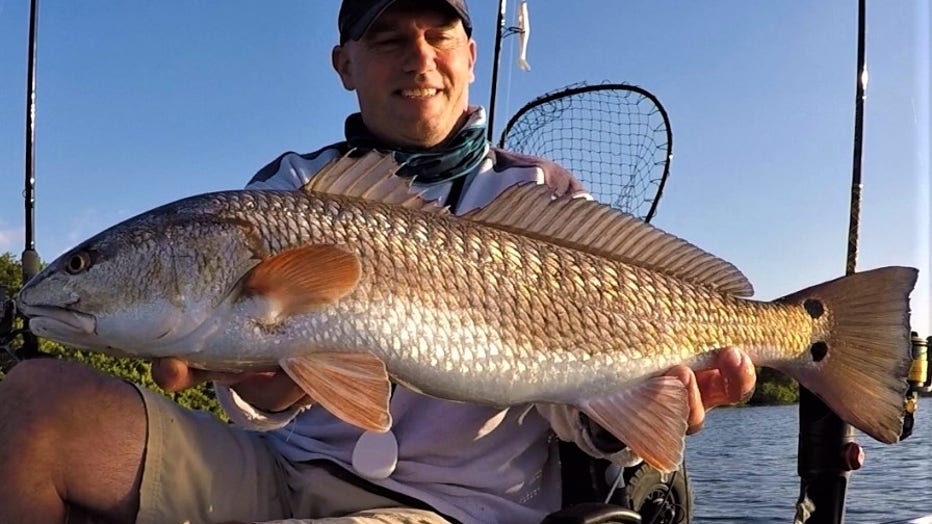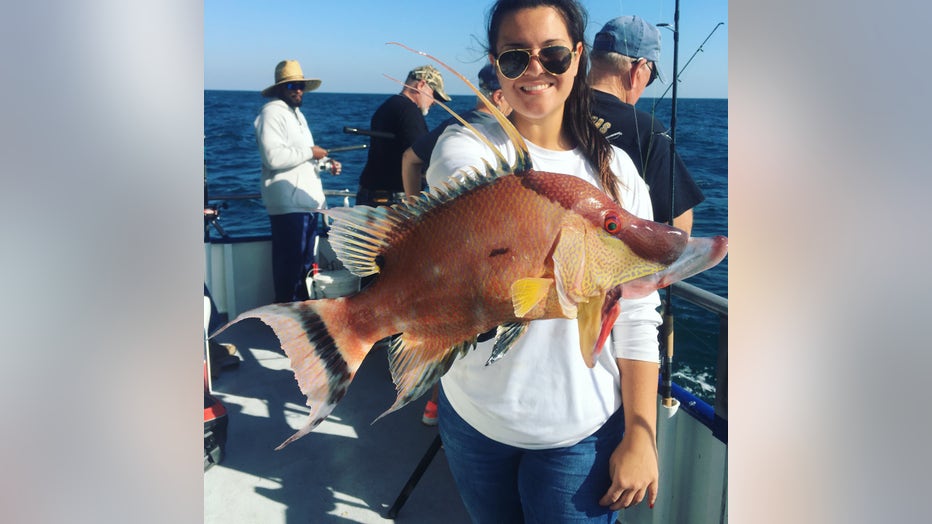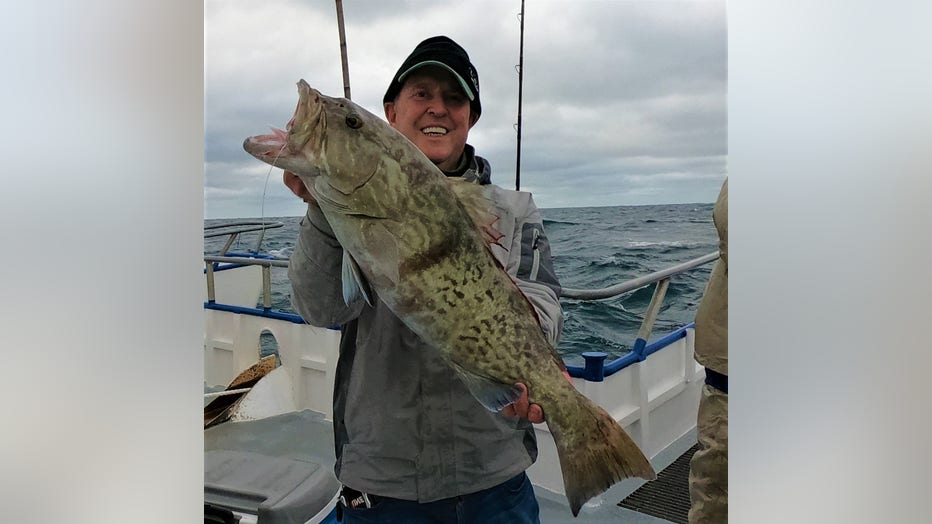Fishing Report: November 22, 2019

Good Catch: Bluefish have moved into the Tampa Bay area
Every Friday morning, Captain Dylan Hubbard of Hubbard's Marina joins Good Day to fill viewers in on his fishing forecast as we head into the weekend. Here is his fishing report for November 22, 2019.
MADEIRA BEACH, Fla. - Every Friday morning, Captain Dylan Hubbard of Hubbard's Marina joins Good Day to fill viewers in on his fishing forecast as we head into the weekend. Here is his fishing report for November 22, 2019.
Inshore
Lately, we are noticing that since the local waters have cooled down, the best inshore bites have occurred in afternoon once it warms up a bit.
Also, the residential docks and canals, mouths of the rivers or upper bays are holding fish now that the local area is cooling off. In the early morning, the fish get a little lethargic from the longer, chilly nighttime periods. You can get them chewing but it’s a bit more difficult. Also, keep in mind that as the waters cool, the fish move more slowly. So, you want to slow down the retrieve of any of your artificial lures as well. They become more opportunistic and lazy when the water is cooler.
We have been seeing snook around the docks, with a few in the pass, and around edges of the mangrove shorelines in shallower water trying to stay warm. Most of them have already moved further back into the bays and coastlines trying to find the shallower and more regulated water temperature areas to stay warm during our brief wintertime here in Florida. Look for them in the early afternoon in the shallower water along the shorelines or around the docks trying to sun themselves. Soft plastics or live bait are great options for these shallower water more spooky fish.
Redfish are around the flats following schools of mullet, towards the mouth of the rivers and bayous, around the residential canal docks and mangrove shorelines too similar to the snook. This time of year, they seem to love the cut dead bait as it requires less energy for them to eat and hunt. Everything becomes more opportunistic and slower as the water cools off in our area.
The big schools of mullet around the flats will become more common, and you can cast some cut mullet in the school and as they pass. Often a big redfish will be ready to eat your bait that’s waiting for them. Finger mullet are great options. Pinfish, big threadfins or ladyfish all work well for the cut bait options on the flats for these redfish.
Trout are hanging around the edges of the flats and mangrove shorelines and moving up around the rivers with redfish and snook. The trout bite lately has been really good and as the waters cool, they seem to cooperate better and better. It’s a great time to get out there and go catch and release some of these fun-to-catch fish. They only require some very light tackle. They are typically congregated. Once you find one, you can find them more easily with the live shrimp or greenbacks as live bait. With artificials, you can use soft plastics or mirror lures or the DOA shrimp.

Redfish caught in shore
Mackerel have been pretty active along the piers and on the beaches this past week. Especially when the waters are clear and bait is present, you can find mackerel and great numbers. Plus, along with the mackerel, lots of bluefish have moved into our area. They are unique-looking fish and are very aggressive schooled-up feeders that take pretty much anything fast-moving, like the mackerel, so you can target them and catch them in the same manner easily while catching the mackerel.
Triple tail are thick around the buoys along the beach and around the mouth of Tampa Bay. Lots of them can be found easily hiding under the crab trap buoys along our beaches. We have seen even some very large ones come out from under the crab trap buoys or the markers around the mouth of Tampa Bay. It’s a great time of year to cruise the floating debris, markers, buoys or anything along the surface to target these prehistoric looking and great-eating fish.
Sheepshead have showed up in force along the docks, bridges and piers -- really any structure around the area will have these guys ready to eat. They are going to get more prolific, aggressive and aggregated as the local waters continue to cool. Plus, when the water is murky and stirred up behind the fronts, these guys even feed better. Cut oysters or clams are great bait for them, but so are those fiddler crabs. Also, in a pinch, you can make small pieces of shrimp great sheepshead bait too.
The mangrove snapper that have been thick around these same structures from the spring through the summer are definitely thinning out and being overrun by these sheepshead. Smaller fish will retreat to the shallow mangrove shorelines to hide out through the winter until they are large enough to head out into the gulf.
Flounder are around the flats, sandy drop offs or potholes around the flats and they love to ambush passing lures or baits that venture too close to their sandy hideout. They will nearly cover themselves up with sand and lie in wait for passing prey items. The trick with these guys is finding the sandy bottom that will hold these guys, then presenting your bait naturally to them just on or near the bottom. My favorite is a soft plastic or DOA lure retrieved very slowly bounced along the bottom at the edge of the flats or in the sandy areas up on the flats.

Triple tail caught inshore
Near shore
Hogfish bite is hot lately with lots of the hogfish around 40 to 70 feet of water. They are loving the live shrimp on our 10 hour all day, near shore private fishing charters or the 5 hour half days too. It’s a great time to get out there and target these uniqu- looking and great eating fish while they are chewing well.
The best time is always pre-front. This early part of the weekend looks great for some hogfish action near shore. They love hard bottom areas with smaller ledges, or even flat hard bottom with the seafans. They love to hide behind those. You can find them on the near shore artificial areas too but sometimes they are a little harder to get on hook-and-line at these areas because there’s so many other aggressive fish around ready to eat your live shrimp.
Mangrove snapper action has also been pretty darn good near shore lately -- a little deeper around 60 to 100 feet of water. We catch plenty of these guys while trying to target the hogfish but I like to catch them best with the double snell rig and chunk of threadfin with 30 to 40-pound test and 4-5ot hooks. Many anglers prefer the spinning reels for these guys but I like my high-speed conventional reels myself.

Hogfish caught near shore (Captain Dylan Hubbard)
The trick is having a very light, sensitive and strong fishing rod to give you the sensitivity needed to set the hook as quickly as you can when you feel these guys start to chew your baits. However, so often I see people trying to set the hook like they would on the flats inshore. Once your past 30 to 40 feet of water this doesn’t work at all. You got to simply reel -- and reel quickly and fast while lifting up on your rod to set the hook by retrieving line into your reel. This is the best method near shore and offshore to make sure you don’t miss the bites and catch more fish.
The grouper bite is also picking up quite a bit near shore even in the shallower waters where we’re starting to see the gag action start heating up. They require some serious tackle though with at least 60lb to start -- while more like 80lb is recommended if you can get them to eat on heavier tackle. That’s even better.
These shallow water, cooler weather gags are very aggressive and very fast to break you off or rock you up. You got to be paying attention and ready while targeting these guys because it’s so very important to start gaining line and lifting as quickly as you can when they hit. Even the most experienced guys will lose a few of these to the bottom when they are super aggressive like this. However, you have to pay attention and be prepared for the best chance of success.
Big live baits like pigfish, pinfish or squirrel fish work well. Also, big dead baits too like big threadfins or even double hooked threadfins or bonita strips are great options. Also, butterflied big live baits that died work well too. Just keep in mind with the big dead baits especially the double threadfins you got to drop those to the bottom extra slowly to prevent them from spinning on the way down, and tangling up your leader which will prevent any gag from taking your bait.
Offshore
Gag grouper are biting very well offshore right now. The trick is finding weather that allows you to get offshore to the great bite we are seeing in the 120 to 200 foot range right now.
The big tackle is better out here with 100lb leader and big 9-10ot hooks with the biggest most frisky live baits or big butterflied dead baits or bonita strips. The trick, like near shore grouper fishing, is being prepared with big bait, big tackle and big patience. When you finally get that big bite, you will be ready to put the hammer down and throw down your most aggressive and explosive power. It will get that reel turning, the rod lifting and that big aggressive gag grouper off the hard bottom ledge or rock pile you found him on.
I cannot tell you how often a bite is shut down when a big gag is broken off or rocked up. They sit down there, grunt, and will shut the bite down in the entire area if you aren’t careful. Make sure while fishing that anyone dropping a big bait -- whether live or dead -- is prepared for the fight with the appropriate tackle and mental mind state of battle time. These fish don’t play and it’s all about getting them off the bottom and into the box as quickly as you can.
Mono is best for grouper fishing, if you have braid on your reel, make sure to add a big top shop. You don’t want these fish to spit your hook once you get them halfway up because your braid allows them too. Nothing is more heartbreaking than winning the battle, getting them off the bottom for the fish to simply come unbuttoned near the surface. Nine out of 10 times this occurs because a braided line was used to catch them.
Mangrove snapper have been cooperating very nicely for us out there in the deeper offshore waters -- very much like near shore fishing -- but they are just larger the deeper you get offshore. We have seen some 8 to 9-pound mangroves as of late, and we’re expecting this trend to continue for now. We’re looking forward to a killer 39-hour overnight fishing trips for the next few weeks targeting the big gag grouper and these larger more aggressive mangrove snapper.
We are seeing plenty of the heads and tails like vermillion, porgies and even a few lanes out there too.
Blackfin tuna are the most common pelagic fish out there in the offshore waters lately and typically through our ‘wintertime’ period we see them the most often. You can get them trolling the Rapala Xraps or flat line fishing too. Sometimes, when you’re fishing a spot awhile or chumming hard you can get them up and around the boat to hit vertical jigs and sometimes even surface lures this time of year.
We are also seeing some kingfish out there. You never know, but this time of year a surprise sailfish or two can sometimes be found.

Gag grouper caught offshore (Captain Dylan Hubbard)

